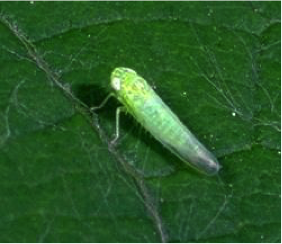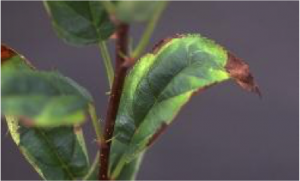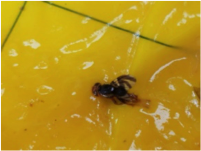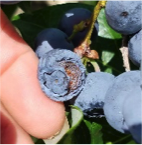Peach:
Oriental Fruit Moth (OFM): Second generation adults are flying in southern and northern counties. Degree day spray timing predictions are updated since last week and are shown below. The second brood often causes the most damage on peaches, since larvae can enter both growing tips and young fruit. Particular attention should be paid to non-bearing orchards that may not be receiving regular insecticide applications. OFM can build up in non-bearing blocks and create pressure for production blocks. The timing for second brood OFM applications is NOW in southern counties where mating disruption is not being used. Growers in northern counties should plan of targeting OFM by the middle of next week.
| OFM 2nd Generation Timing | ||||
| Insecticide Type | ||||
| County/Region | Degree Days by 6/26 base 45 | Conventional
Target DD 1150-1200, 1450-1500 |
Intrepid / IGRs
Target DD 1100-1150, 1400-1450 |
Diamides
Target DD 1075-1150, 1375-1450 |
| Gloucester – Southern – Biofix 4/27 | 1375 | 1st – past
2nd – 6/28-30 |
1st – past
2nd – 6/27-28 |
1st – past
2nd – 6/26-29 |
| Hunterdon –Northern – Biofix 5/1 | 1200 | 1st – 6/24-6/26
2nd – 7/2-7/4 |
1st – past
2nd – 6/30-7/2 |
1st – 6/22-25
2nd – 6/29-7/2 |
Tufted Apple Budmoth (TABM): The first flight is decreasing, but relatively high population pressure is present in a number or North Jersey orchards. Treatments applied for Oriental Fruit Moth should control TABM. If you have mating disruption up for OFM AND you have very high counts of TABM in your traps, consider a supplemental insecticide application for TABM. See last newsletter for further discussion.
Brown Marmorated Stink Bug (BMSB): Adults are occasionally seen during orchard scouting. BMSB pressure is very low at the present time, although some early season injury is present in scattered orchard blocks. Weekly border applications of effective materials has been shown to work better that full cover sprays on a 7-10+ day interval.
Thrips: Thrips are present in beating tray samples in a number of peach orchards. These insects will often become a problem during periods of prolonged hot dry weather. Since we are starting to enter such a weather pattern, caution is suggested as early fruit begins to ripen. Delegate is the product of choice, but Lannate can also be effective.
Apple (and Pear):
Potato Leafhopper (PLH): PLH adults and nymphs are present and easily seen in southern county apple orchards. PLH are sometimes accompanied by rose leafhoppers and later, white apple leafhoppers. Rose and white apple leafhoppers DO NOT vector fire blight, while PLH do vector fire blight. PLH can b e distinguished by their slight green color, as opposed to white for the other 2 species. PLH will also cause a leaf burn on the leaf margins, often referred to as ‘hopperburn’. We don’t usually worry about the hopperburn, since it is usually minimal. However, since fire blight is present in many orchards, you should tolerate only a very few PLH if fire blight is also present. See PLH adult and leaf burn symptoms in figures 1 and 2. The preferred materials for leafhopper control include Actara, Assail, Belay, Besiege, Closer, Endigo, imidacloprid/Admire, Sivanto, Voliam Flexi, and Warrior/Lambda Cyhalothrin.

Potato leafhopper adult – Univ of KY

Potato leafhopper hopperburn. Univ of KY
Green Apple Aphids and Spirea Aphid Complex: Aphid populations have increased slightly in a number of orchards. The treatment threshold is set at 50% of terminals with active aphids present. You really don’t have to treat until you get close to this level. Aphid predators are usually present when aphid populations reach about half this level, unless the orchard is receiving repeated applications of pyrethroid insecticides that will kill most predator populations. The green aphid complex does not vector fire blight. Very high populations will affect the vigor of young trees and do need to be controlled if populations are above the treatment threshold.
European Red Mite (ERM): Mite populations have started to build. Treatment levels have been reached in some southern orchards and have been treated. Zeal (Valent – IRAC group 10B – etoxazole @ 2-3 oz/A) and Nealta (BASF-IRAC group 25 – cyflumetofen @ 13.7 oz/A) use has been successful in recent years. Nealta is not labeled for stone fruit.
Grape:
Grape Berry Moth (GBM): A biofix (wild grape bloom) was set for May 28 in Gloucester County, using the MSU/Penn State/Cornell model. As of June 19, we had 490 degree days accumulated since Biofix. We need a total of 810 DD before treatment with an insect growth regulator (Intrepid) or a diamide like Altacor. The model predicts that applications using growth regulators likely should be made in southern counties on or about June 30. However egg hatch was observed to start about 6/22 in Atlantic County, more than a week ahead of the model prediction. Therefore applications for grape berry moth should be made in all parts of the state this week and growers in southern and central counties should probably avoid materials like Intrepid and Altacor.
Scouting Calendar Tree Fruit Southern Counties
The following table is intended as an aid for orchard scouting. It should not be used to time pesticide applications. Median dates for pest events and crop phenology are displayed. These dates are compiled from observations made since 1995 in Gloucester County. Events in northern New Jersey should occur 7-10 days later.
Pest Event or Growth Stage |
Approximate Date | 2018 Observed Date |
| Bud Swell (Redhaven) | March 23 +/- 15 Days | March 26 |
1/4″ Green Tip Red Delicious |
March 31 +/- 13 Days | April 2 |
Pink Peach (Redhaven) |
April 4 +/- 15 Days | April 10 |
Tight Cluster Red Delicious |
April 9 +/- 13 Days | April 16 |
Oriental Fruit Moth Biofix |
April 9 +/- 13 Days | April 27 |
Full Bloom Peach (Redhaven) |
April 9 +/- 14 Days | April 20 |
Pink Apple (Red Delicious) |
April 14 +/- 12 Days | April 30 |
Codling Moth Biofix |
April 27 +/- 13 Days | May 5 |
Green Peach Aphid Observed |
April 16 +/- 16 Days | May 21 |
Full Bloom Apple (Red Delicious) |
April 22 +/- 11 Days | May 3 |
Petal Fall (Redhaven) |
April 22 +/- 10 Days | May 1 |
Petal Fall (Red Delicious) |
April 27 +/- 14 Days | May 7 |
Shuck Split (Redhaven) |
April 30+/- 11 Days | May 7 |
First PC Oviposition Scars Observed |
May 3 +/- 18 Days | May 14 |
Tufted Apple Bud Moth Biofix |
May 4 +/- 10 Days | May 12 |
San Jose Scale Crawlers |
June 2 +/- 8 Days | June 1 |
Pit Hardening Peach |
June 16 +/- 8 Days | June 12 |
Tree Fruit Trap Counts – Southern Counties
| Weekending | STLM | TABM-A | CM | AM | OFM-A | DWB | OFM-P | TABM-P | LPTB | PTB | |
| 5/12 | 2 | 2 | 10 | 117 | 32 | ||||||
| 5/19 | 8 | 5 | 10 | 53 | 3 | 7 | |||||
| 5/26 | 0 | 8 | 28 | 53 | 3 | 6 | 45 | ||||
| 6/2 | 2 | 11 | 1 | 19 | 0 | 10 | 27 | ||||
| 6/9 | 4 | 10 | 9 | 39 | 42 | 4 | 19 | 55 | |||
| 6/16 | 11 | 11 | 8 | 14 | 181 | 5 | 10 | 4 | 0 | ||
| 6/23 | 17 | 4 | 5 | 98 | 2 | 8 | 27 | 11 | |||
Tree Fruit Trap Counts – Northern Counties
| Weekending | STLM | TABM-A | CM | AM | OFM-A | DWB | OBLR | OFM-P | TABM-P | LPTB | PTB |
| 4/7 | 0 | ||||||||||
| 4/14 | 4 | ||||||||||
| 4/21 | 11 | 0 | 0 | ||||||||
| 4/28 | 15 | 0 | 0 | 0 | |||||||
| 5/5 | 17 | 0 | 0 | 0 | 1 | ||||||
| 5/12 | 30 | 0 | 0.2 | 7 | 16.9 | 0 | 0 | ||||
| 5/19 | 26 | 0.3 | 1.8 | 3.7 | 0 | 0 | 4.5 | 0.4 | 1.1 | 0 | |
| 5/26 | 43 | 2.2 | 2.5 | 4.6 | 0 | 0 | 6.1 | 1.4 | 11.8 | 2 | |
| 6/2 | 4 | 7.2 | 2.4 | 4 | 0.7 | 0 | 5.1 | 11.3 | 14.9 | 0 | |
| 6/9 | 10 | 20.8 | 5 | 3.3 | 1.2 | 12 | 6.6 | 22.2 | 18.5 | 0.8 | |
| 6/16 | 13 | 42.3 | 4.6 | 7.4 | 0.3 | 31 | 2.9 | 96 | 12.7 | 0.3 | |
| 6/23 | 54 | 42.8 | 5.8 | 3 | 0.6 | 17 | 4.7 | 60.5 | 9.3 | 0.4 |
Blueberry:
Plum Curculio (PC): During this past week of scouting, numbers have significantly decreased on injured infested fruit. Our average count was 0.002 infested fruit per bush, with a high of 0.2 infested fruit per bush. Very low numbers of adults are being found in traps. Only 1 adult was found in a trap in Atlantic County.
Spotted Wing Drosophila (SWD): Trap counts are still minimal but more trap locations are turning positive for adult flies. Numbers should increase over the next several weeks. In Atlantic County our average trap count was 0.176 with a high of 1 male per trap. In Burlington County our average trap count was 0.5 per trap with a high of 3. While these numbers may seem low, remember that this is only an indication of relative abundance, and means nothing about whether or not you have SWD. There are larvae in unsprayed fruit. All remaining Duke, Draper, and Bluecrop and anything else with color should be under a treatment schedule.
Blueberry Maggot (BBM): The first BBM adult was trapped on June 22nd in a non-commercial field. We will be seeing more BBM adults during the coming weeks. This is a regulated pest and needs to be treated under a strict protocol if exporting to Canada. All treatments being used for SWD will control BBM, except Delegate if high populations are present. Growers on a Delegate rotation should have BBM traps in their fields so that Delegate use can be coordinated with low to “0” trap counts of BBM.

BBM fly adult on yellow sticky trap. Photo – Carrie Denson
Oriental Beetle (OB): This week’s traps have significantly increased. The maximum trap level in Atlantic County was 6075, and 4050 per trap in Burlington County. Based on past experience, these farms are virtually guaranteed to have grub problems later in the year or early next year. Treatments need to be applied by the middle of July, or mating disruption used the following year (since it is too late to apply mating disruption dispensers this year).
Cranberry Fruitworm (CBFW): CBFW trap captures are pretty much “0” with a few ‘stragglers’. This pest is no longer a concern.
Aphids: Aphid populations are hanging on in several locations, and have slightly increased since last week with an average count of 9.6% infested shoots, with a high of 88%. Colony size averages 6 to 10 aphids per shoot. Many growers have already made 2 applications of a neonicotinoid for aphid control. If this is the case, and significant aphid populations are still present, then you are seeing very little return for the spray, most likely from the material not reaching the target. Aphid materials will not control SWD, and SWD is the main target at this time. So unless you can change your application coverage, let the aphids go and concentrate on the SWD.
Sharpnosed Leafhopper (SNLH): Trap counts of adult leafhoppers increased slightly since last week. We should see increased captures over the next couple of weeks, but adults should be controlled by the materials being used for SWD.
Putnam Scale: Crawlers are visible in some fields. There are 2 generations per year with this being the first generation. Tape traps will monitor the length of the first crawler generation and help define the window for treatment if some growers want to take that option.
Anthracnose: Some field Anthracnose is present on both Duke and Bluecrop. Numbers of infested fruit per bush are low (.06 per bush), but since this disease can increase rapidly in packed containers, any field level is cause for concern.

Anthracnose on berry. Photo – Carrie Denson
Summary of insect counts seen during the week of June 17th – 23rd
| Leafroller % Inj. Shoots | Aphids % Inf. Shoots | CBFW % Inf. Fruit | Leafroller % Shoots Inf. | Plum Curculio % Inj Frt | |
| Average | 0.179 | 9.61 | 0.005 | 0.037 | 0.002 |
| High | 18 | 88 | 1 | 2 | 0.2 |
Blueberry Trap Captures – Atlantic County
| Week Ending | PC | CBFW | OB | SWD | BBM | SNLH |
| 5/26 | 0.43 | 0.0 | ||||
| 6/2 | 0.43 | 0.0 | ||||
| 6/9 | 0.09 | 0.43 | 5.4 | |||
| 6/16 | 0 | 0.015 | 31.75 | 0.02 | 0 | 0.072 |
| 6/23 | 0.285 | 0.015 | 1436 | 0.176 | 0.024 | 0.104 |
Blueberry Trap Captures – Burlington County
| Week Ending | PC | CBFW | OB | SWD | BBM | SNLH |
| 5/26 | 1.67 | 0.18 | ||||
| 6/2 | 0.67 | 0.16 | ||||
| 6/9 | 0.0 | 0.1 | 0.6 | |||
| 6/16 | 0 | 0.5 | 38.52 | 0.15 | 0 | 0 |
| 6/23 | 0 | 0 | 1016 | 0.5 | 0 | 0 |

